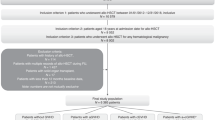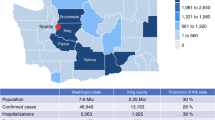Summary:
Autopsy series have revealed patterns of injury in graft-versus-host disease and provided insight into infectious and toxic complications following hematopoietic stem cell transplantation (HSCT). Overall autopsy rates have declined significantly in recent decades including specialized services such as neonatal medicine and cardiac care. However, rates of post-mortem exams at HSCT centers have not been specifically documented. We reviewed hospital records between 1992 and 2002 to determine overall autopsy rates at our hospital and within the HSCT program. Although the overall autopsy rate declined steadily from 24% in 1992 to 9% in 2002, rates of post-mortem exams in the HSCT program remained relatively stable at 32% (24–46%). Autopsy rates were not significantly different for recipients of allogeneic vs autologous transplants and no clear difference was observed for the proportion of autopsies requested on weekdays compared with weekends. Autopsies confirmed major clinical diagnoses and/or suspected causes of death in 45 of 61 autopsies (74%) and yielded major or minor disagreements in clinical diagnosis in 10 cases (16%) and seven cases (11%), respectively. The preservation of high rates of autopsy within our HSCT program demonstrates that specialized programs are able to maintain elevated rates of post-mortem examinations despite overall declining rates.
This is a preview of subscription content, access via your institution
Access options
Subscribe to this journal
Receive 12 print issues and online access
$259.00 per year
only $21.58 per issue
Buy this article
- Purchase on Springer Link
- Instant access to full article PDF
Prices may be subject to local taxes which are calculated during checkout

Similar content being viewed by others
References
Sinard JH . Factors affecting autopsy rates, autopsy request rates, and autopsy findings at a large academic medical center. Exp Mol Pathol 2001; 70: 333–343.
Brodlie M, Laing IA, Keeling JW, McKenzie KJ . Ten years of neonatal autopsies in a tertiary referral centre: retrospective study. BMJ 2002; 324: 761–763.
Burton EC, Troxclair DA, Newman III WP . Autopsy diagnoses of malignant neoplasms: how often are clinical diagnoses incorrect? JAMA 1998; 280: 1245–1248.
Thiele J, Varus E, Wickenhauser C et al. Regeneration of heart muscle tissue: quantification of chimeric cardiomyocytes and endothelial cells following transplantation. Histol Histopathol 2004; 19: 201–209.
Weimann JM, Charlton CA, Brazelton TR et al. Contribution of transplanted bone marrow cells to Purkinje neurons in human adult brain. Proc Natl Acad Sci USA 2003; 100: 2088–2093.
Cogle CR, Yachnis AT, Laywell ED et al. Bone marrow transdifferentiation in brain after transplantation: a retrospective study. Lancet 2004; 363: 1432–1437.
Gunsilius E, Duba H-C, Petzer A et al. Evidence from a leukemia model for maintenance of vascular endothelium by bone-marrow-derived endothelial cells. Lancet 2000; 355: 1688–1691.
Marwick C . Pathologists request autopsy revival. JAMA 1995; 273: 1889–1891.
Akpek G, Chinratanalab W, Lee LA et al. Gastrointestinal involvement in chronic graft-vs-host disease: a clinicopathologic study. Biol Blood Marrow Transplant 2003; 9: 46–51.
de Medeiros BC, de Medeiros CR, Werner B et al. Central nervous system infections following bone marrow transplantation: an autopsy report of 27 cases. J Hematother Stem Cells 2000; 9: 535–540.
Bleggi-Torres LF, Werner B, Gasparetto EL et al. Intracranial hemorrhage following bone marrow transplantation: an autopsy study of 58 patients. Bone Marrow Transplant 2002; 29: 29–32.
Bleggi-Torres LF, de Medeiros BC, Werner B et al. Neuropathological findings after bone marrow transplantation: an autopsy study of 180 cases. Bone Marrow Transplant 2000; 25: 310–317.
Wojno KJ, Vogelsang GB, Beschorner WE et al. Pulmonary hemorrhage as a cause of death in allogeneic bone marrow recipients with severe acute graft-vs-host disease. Transplantation 1994; 57: 88–92.
McKelvie PA, Rode J . Autopsy rate and a clinicopathological audit in an Australian metropolitan hospital – cause for concern? Med J Aust 1992; 156: 456–462.
Bauer FW, Robbins SL . An autopsy study of cancer patients, I: accuracy of the clinical diagnoses (1955 to 1965) Boston City Hospital. JAMA 1972; 221: 1471–1474.
Wells HG . Relation of clinical to necropsy diagnosis in cancer and value of existing cancer statistics. JAMA 1923; 80: 737–740.
Chariot P, Witt K, Pautot V et al. Declining autopsy rate in a French hospital: physician's attitude to the autopsy and use of autopsy material in research publications. Arch Pathol Lab Med 2000; 124: 739–745.
Clayton SA, Sivak SL . Improving the autopsy rate at a university hospital. Am J Med 1992; 92: 423–428.
Haque AK, Patterson RC, Grafe MR . High autopsy rates at a university medical center. What has gone right? Arch Pathol Lab Med 1996; 120: 727–732.
Acknowledgements
We wish to acknowledge the assistance of Ms Karine Pelletier and Ms Michèle Joseph for their help in searching hospital databases. David Allan is a recipient of an unrestricted BMT Fellowship Award from Fujisawa Canada Inc.
Author information
Authors and Affiliations
Corresponding author
Rights and permissions
About this article
Cite this article
Allan, D., Bélanger, R., Busque, L. et al. Maintaining high autopsy rates in a Canadian blood and marrow transplant program: preserving a diagnostic and research tool. Bone Marrow Transplant 35, 781–785 (2005). https://doi.org/10.1038/sj.bmt.1704869
Received:
Accepted:
Published:
Issue Date:
DOI: https://doi.org/10.1038/sj.bmt.1704869
Keywords
This article is cited by
-
Autopsy among recipients of stem cell transplant for hematologic malignancies in the modern era
Bone Marrow Transplantation (2021)
-
High rate of discordance between clinical and autopsy diagnoses in blood and marrow transplantation
Bone Marrow Transplantation (2007)



